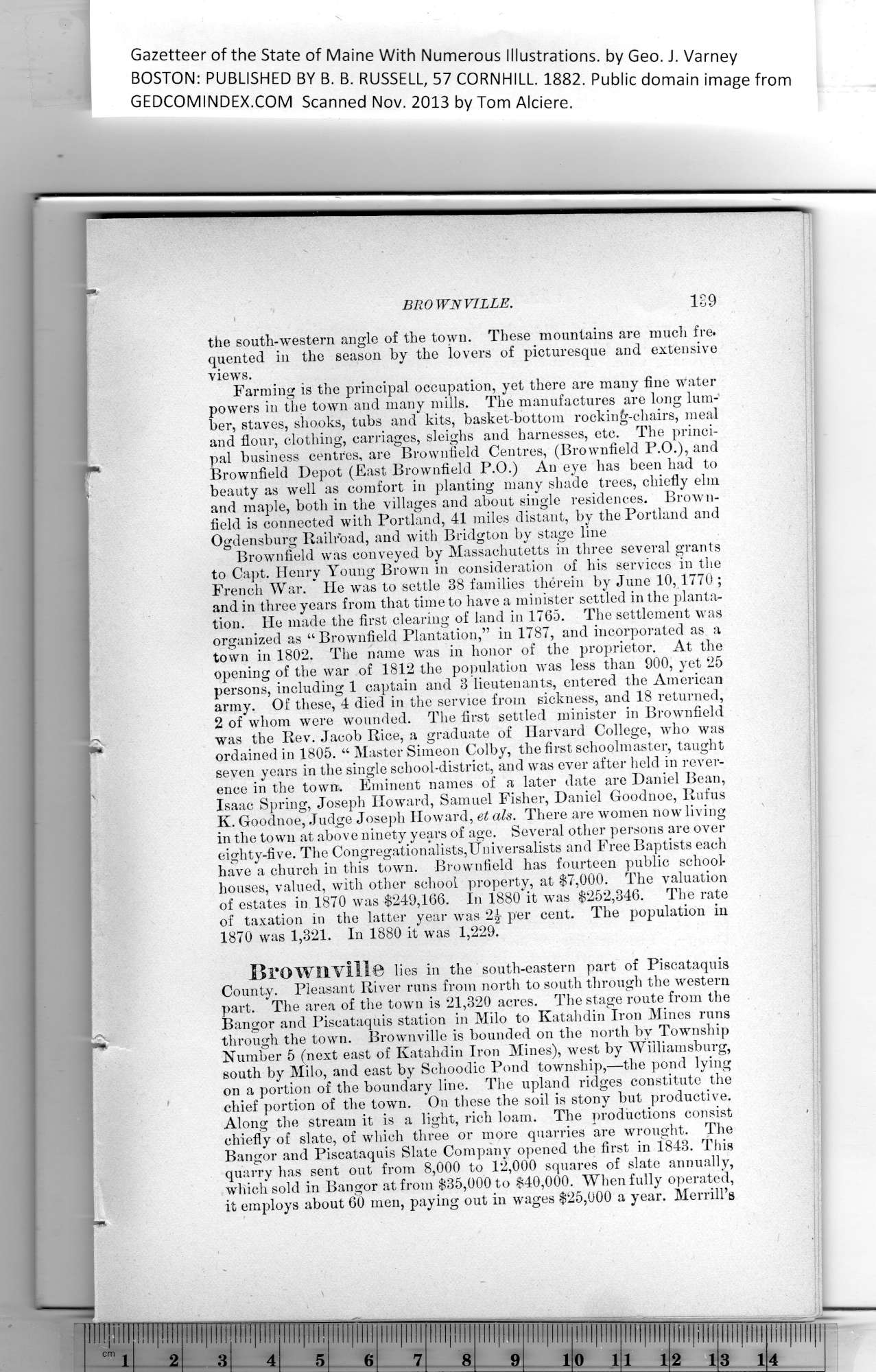|
Gazetteer of the State of Maine With Numerous Illustrations, by Geo. J. Varney
1 BOSTON: PUBLISHED BY B. B. RUSSELL, 57 CORNHILL. 1882. Public domain image from
BRO WNVILLE. IS 9
the south-western angle of the town. These mountains are mucli fre.
quented in the season by the lovers of picturesque and extensive
views.
Farming is the principal occupation, yet there are many fine water
powers in the town and many mills. The manufactures are long lum-
ber, staves, shooks, tubs and kits, basket-bottom rocking-chairs, meal
and flour, clothing, carriages, sleighs and harnesses, etc. The princi-
pal business centres, are Brownfield Centres, (Brownfield P.O.), and
Brownfield Depot (Fast Brownfield P.O.) An eye has been had to
beauty as well as comfort in planting many shade trees, chiefly elin
and maple, both in the villages and about single residences. Brown-
field is connected with Portland, 41 miles distant, by the Portland and
Ogdensburg Railroad, and with Bridgton by stage line
Brownfield was conveyed by Massachutetts in three several grants
to Capt. Henry Young Brown in consideration of his services in the
French War. He was to settle 38 families therein by June 10,1770 ;
and in three years from that time to have a minister settled in the planta-
tion. He made the first clearing of land in 1765. The settlement was
organized as “Brownfield Plantation,” in 1787, and incorporated as a
town in 1802. The name was in honor of the proprietor. At the
opening of the war of 1812 the population was less than 900, yet 25
persons, including 1 captain and 3 lieutenants, entered the American
army. Of these, 4 died in the service from sickness, and 18 returned,
2 of whom were wounded. The first settled minister in Brownfield
^ was the Rev. Jacob Rice, a graduate of Harvard College, who was
ordained in 1805. “ Master Simeon Colby, the first schoolmaster, taught
seven years in the single school-district, and was ever after held in rever-
ence in the town. Eminent names of a later date are Daniel Bean,
i Isaac Spring, Joseph Howard, Samuel Fisher, Daniel Goodnoe, Rufus
| K. Goodnoe, Judge Joseph Howard, et als. There are women now living
in the town at above ninety years of age. Several other persons are over
eighty-five. The Congregationalists,Universalists and Free Baptists each
have a church in this town. Brownfield has fourteen public school*
houses, valued, with other school property, at $7,000. The valuation
of estates in 1870 was $249,166. In 1880 it was $252,346. The rate
of taxation in the latter year was 2^ per cent. The population in
1870 was 1,321. In 1880 it was 1,229.
BrownvilXe lies in the south-eastern part of Piscataquis
County. Pleasant River runs from north to south through the western
part. The area of the town is 21,320 acres. The stage route from the
Bangor and Piscataquis station in Milo to Katahdin Iron Mines runs
through the town. Brownville is bounded on the north by Township
Number 5 (next east of Katahdin Iron Mines), west by Wiiliamsburg,
south by Milo, and east by Schoodic Pond township,—tbe pond lying
on a portion of tbe boundary line. The upland ridges constitute the
chief portion of the town. On these the soil is stony but productive.
Along the stream it is a light, rich loam. The productions consist
chiefly of slate, of which three or more quarries are wrought. The
Bangor and Piscataquis Slate Company opened the first in 1843. This
quarry has sent out from 8,000 to 12,000 squares of slate annually,
which sold in Bangor at from $35,000 to $40,000. When fully operated,
it employs about 60 men, paying out in wages $25,000 a year. Merrill’s
PREVIOUS PAGE ... NEXT PAGE
This page was written in HTML using a program written in Python 3.2
|
